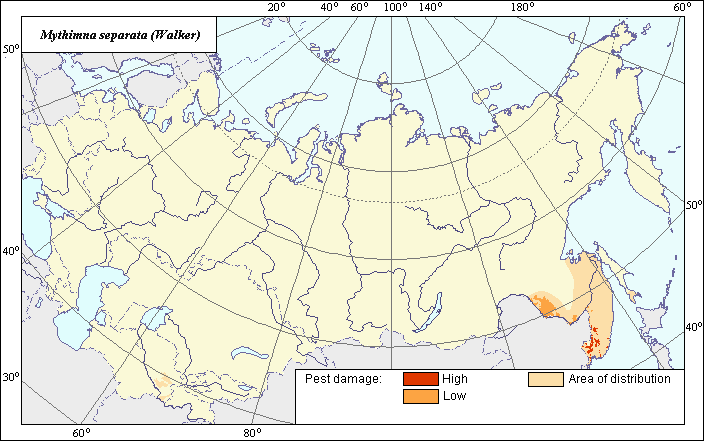Pests
Area of distribution and damage of the Oriental Armyworm (Mythimna separata Wlk.)
 Object description Download GIS-layers
Object description Download GIS-layers
Authors:
Object biologists - M.A. Chumakov, T.L. Kuznetsova,GIS-specialist - M.I. Saulich.
Date of creation:
27.06.2005.Scale:
1:20.000.000.Accuracy of map:
map was created based on materials of maps of natural scale 1: 33.000.000.Projection:
"Alber.s Equal Area Conic for the USSR", 9, 1001, 7, 100, 0, 44, 68, 0, 0.Basic contents:
Vector map of 3 layers. Area and damage zones are shown by polygons.Accuracy of the classifier:
Potential area of the Oriental Armyworm includes imago collecting sites during extensive migrations of moths with monsoon winds and air streams of a cyclonic origin (Berger, 1985; Makarova & Doronina, 1988, 1994; Pospelov, 1989). Two damage zones were defined within the moth area: 1) high damage (density of larvae is 10 and more individuals per 1 sq.m on the average at 50% and more areas invaded); 2) low damage (density of larvae is less than 10 individuals per 1 sq.m). The subdivision of zones was determined according to a rise in the phase of pest population dynamics after periods of depression when the species doesn.t show a high degree of harmfulness (Berger, 1985; Onisimova et al., 1987; Makarova & Doronina, 1988; Pospelov, 1989).Procedure of map drawing:
Distribution and damage zones were drawn according to the analysis of map materials and literature data published (Onisimova et al., 1987; Pospelov, 1989; Makarova & Doronina, 1994; Sukhareva, 1999; Kononenko, 1988, 2003; Sharma & Sullivan, 2000). The pest damage zones were corrected according to the vector layer of I.E. Koroleva et al. characterising the arable lands distribution.Sources of the data:
Berger, L.P. 1985. Prediction of population dynamics of Mythimna separata in the Far East. In: Polyakov, I.Ya., ed. Automation principles of phytosanitary diagnostics. Proceedings of VIZR, issue 79, Leningrad: VIZR, p. 68-75 (in Russian).Kononenko, V.S. 1988. Noctuidae. In: Belyaev, E.A. et al., eds. Butterflies - pests of the Far Eastern agriculture and forestry. Keys.Vladivostok: DVO AN SSSR, p. 217-262 (in Russian).
Kononenko, V.S. 2003. Noctuidae. In: Ler P.A., ed. Keys to the insects of the Russian Far East. V. 5(4). Trichoptera and Lepidoptera. Vladivostok: Dal.nauka, 688 p. (in Russian).
Makarova, L.A & Doronina, G.M. 1988. Agrometeorological predictors for forecasting the reproduction of agricultural crop pests. Leningrad: Gidrometeoizdat, 214 p. (in Russian).
Makarova, L.A & Doronina, G.M. 1994. The synoptic approach to forecasting long-range migration of insect pests. St.- Petersburg: Gidrometeoizdat, 199 p. (in Russian).
Onisimova, Z.G., Kononenko, V.S., Belyaev, E.A., Tovba, M.S. 1987. The Oriental armyworm - pest of grain crops. In: Leley, A.S., ed. Vladivostok: DVO AN SSSR, 82 p. (in Russian).
Pospelov, S.M. 1989. Noctuids - pests of agricultural crops. Moscow: Agropromizdat, 112 p. (in Russian).
Sharma, H.C., Sullivan, D.J. 2000. Screening for Plant Resistance to Oriental Armyworm, Mythimna separata (Lepidoptera: Noctuidae) in Pearl Millet, Pennisetum glacum. J. Agric. Urban Entomol. 17(3): 125-134.
Sukhareva, I.L. 1999. Noctuidae. In: Kuznetsov, V.I., ed. Insects and mites - agricultural pests. V. 3, part 2. Lepidoptera. St.Petersburg: Nauka, p. 332-378 (in Russian).
Rights and copyrights:
All rights reserved. Copyright 2005 & M.A. Chumakov, T.L. Kuznetsova, & M.I.Saulich (VIZR; vector map, description).Photo is given with kind permission of Kononenko,V.S.( Biology-soil institute of DVO AN RUSSIA).

